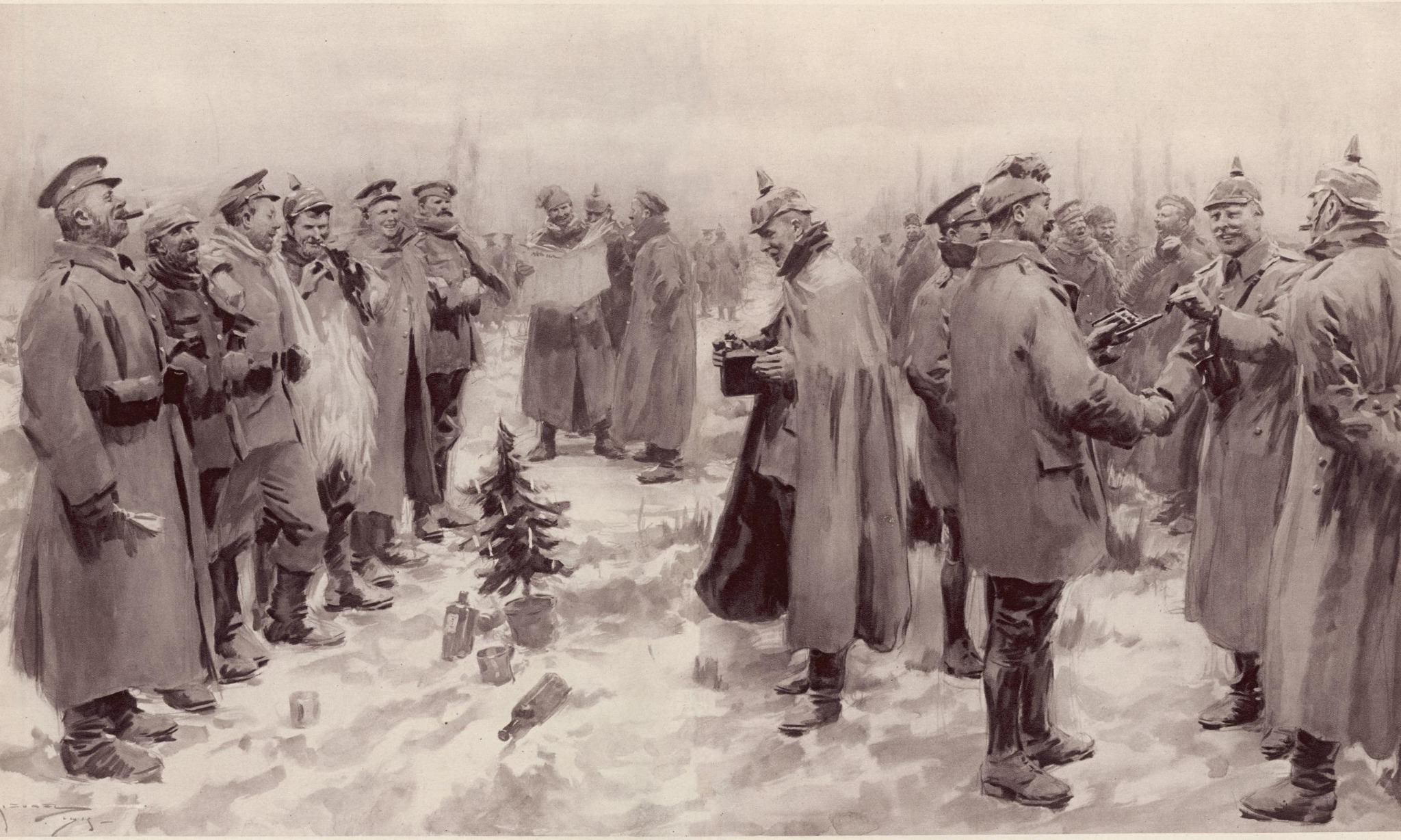The Christmas Truce

Pine trees, ornaments, warm milk and cookies, turkey, candles, and mistletoes, not to forget dear old Santa Claus. Yes, it is that time of the year again, folks – Good old Christmas. It is the time for peace and silence, when all life seems to slumber, waiting for the blooming floras of spring, when all sounds cease to disturb the quietness of the cold… even the roaring gunfire on the Western Front of World War I dared not trouble the mighty Ice Queen.
December 1914, 5 months after the assassination of the Austro-Hungarian prince, Europe, as well as the world, entered its grimmest winter. Continuous bombardment on No Man’s Land from howitzers was enough to dishearten even the bravest soldiers. On the Eastern Front were the talented British, the relentless French and the mighty Austro-Hungarians (or modern-day Germans). The war was cruel: gunmen were forced into battle by the ear-piercing whistles of their officers and Lugers pointed to their backs. It is evident everyone had had it with the fighting. Yet none of them realized the powerful implications of their passion for peace.
On the 25th, strange things happened on the front lines. There was complete silence. Yet the moment of silence differed from those of the other nights. It felt of peace, of serenity, as sung by churches of old, it bore a spirit that soldiers have missed in too long a time. Had it been Christmas already? White flags started to fly across trench lines, almost blending with the snowy battlegrounds, as silhouettes emerge from the mucky trenches. “Silent night” sung in German echoes through the serene nights. Paranoia spread throughout the British front, adding to the already-present confusion. But the holiday spirit soon warmed the hearts of militiamen, urging them to join the carol. Adversaries joined hands to sing for Christmas on No Man’s Land.
The Christmas Truce was undoubtedly one of the strangest things that has happened in our long history of bloodshed, and is one of the most momentous events in winter to this date. The fact that both sides decided to put down their arms in order to celebrate the Christmas cheer sounds almost too pure to be true. But have you ever wondered what are the myths and the facts of this event? And how did it start? Or was it just the same old “Great minds think alike”?
On December 7, 1914, Pope Benedict XV suggested a temporary hiatus of the war for the celebration of Christmas. It was fairly obvious no countries would give in to such wild proposals. But the soldiers are not like their countries. Official cease-fires were not issued, but on Christmas the soldiers in the trenches declared their own unofficial truce, heeding the call for peace.
Starting on Christmas Eve, many German and British troops sang Christmas carols to each other across the lines, and at certain points the Alliance soldiers even heard brass bands joining the Germans in their joyous singing – an unfamiliar sight, especially in war. At the first light of dawn on Christmas Day, some German soldiers emerged from their trenches and approached the Alliance lines across no-man’s-land, calling out “Merry Christmas” in their enemies’ native tongues. “A trick, could it have been?” - the Alliance soldiers feared. But the Germans showed no sign of aggression; unarmed, they climbed out of their trenches and shook hands with the enemy soldiers. Fraternal, but treason nonetheless.
What we, as descendants, have forgotten of this joyful meeting was that it was never that peaceful. Commanders noticed their men climbing out of trenches to socialize with those whom they sought to kill; raged filled their minds as they loaded up their pistols and aimed at their own comrades. Some were more aggressive, ordering their men to point their SMLEs at their brothers-in-arms as well as their enemies. One even killed a German soldier as he stepped out from his trench. But that never stopped the Christmas spirit.
The men exchanged presents of cigarettes and plum puddings and sang carols and songs. There was even a documented case of soldiers from opposing sides playing a good-natured game of soccer. The “Live and let live” system bloomed with soldiers from both sides taking advantage of this cease-fire to find and bury their allies in No Man’s Land (which had been impossible before during the shelling).
News of this quickly got to the generals who, when heard, reacted with, not joy and surprise, but war-driven anger. Orders quickly traveled to front lines. Hostility re-established.
The so-called Christmas Truce of 1914 came only five months after the outbreak of war in Europe and was one of the last examples of the outdated notion of chivalry between enemies in warfare. It was never repeated—future attempts at holiday ceasefires were quashed by threats of disciplinary action—but it served as heartening proof that beneath the brutal clash of weapons, the soldiers’ essential humanity endured.

0 Comments Add a Comment?